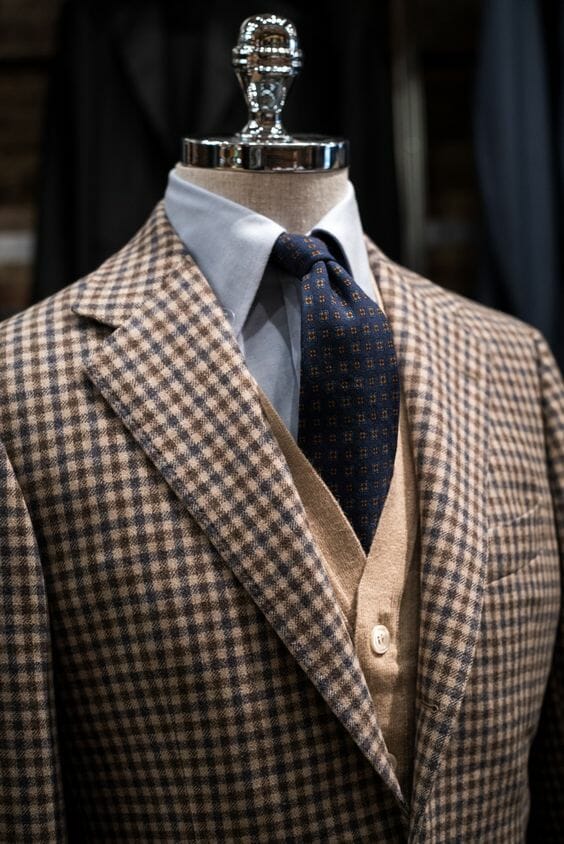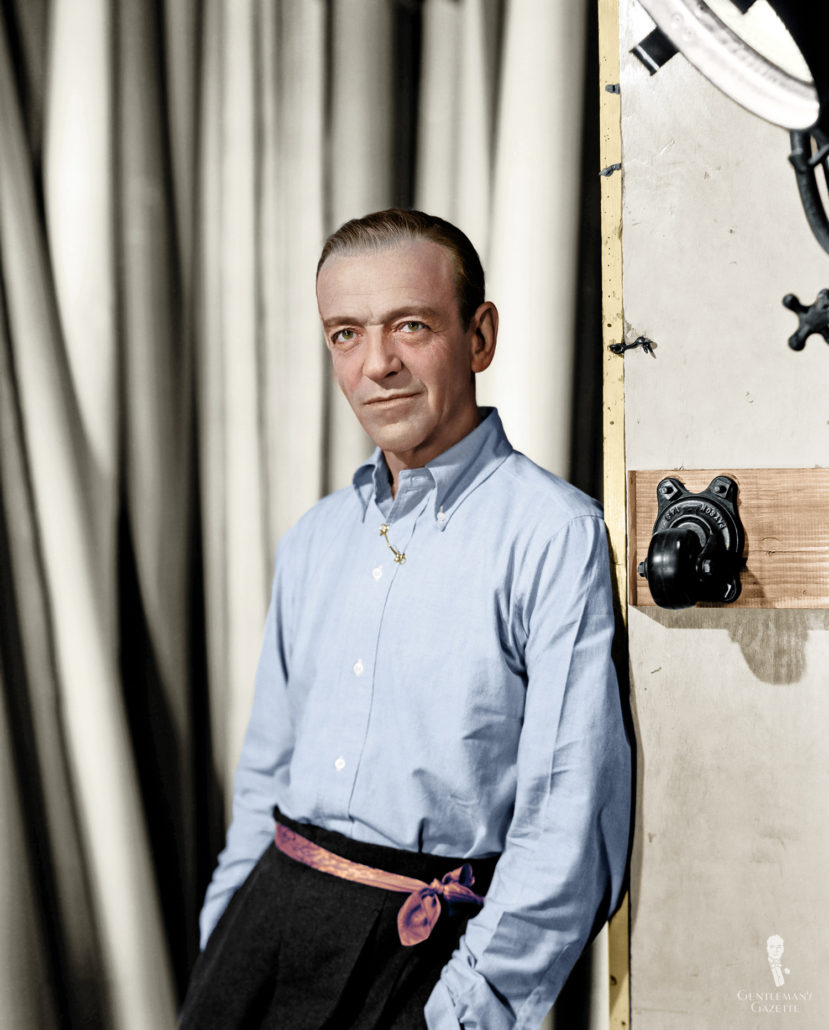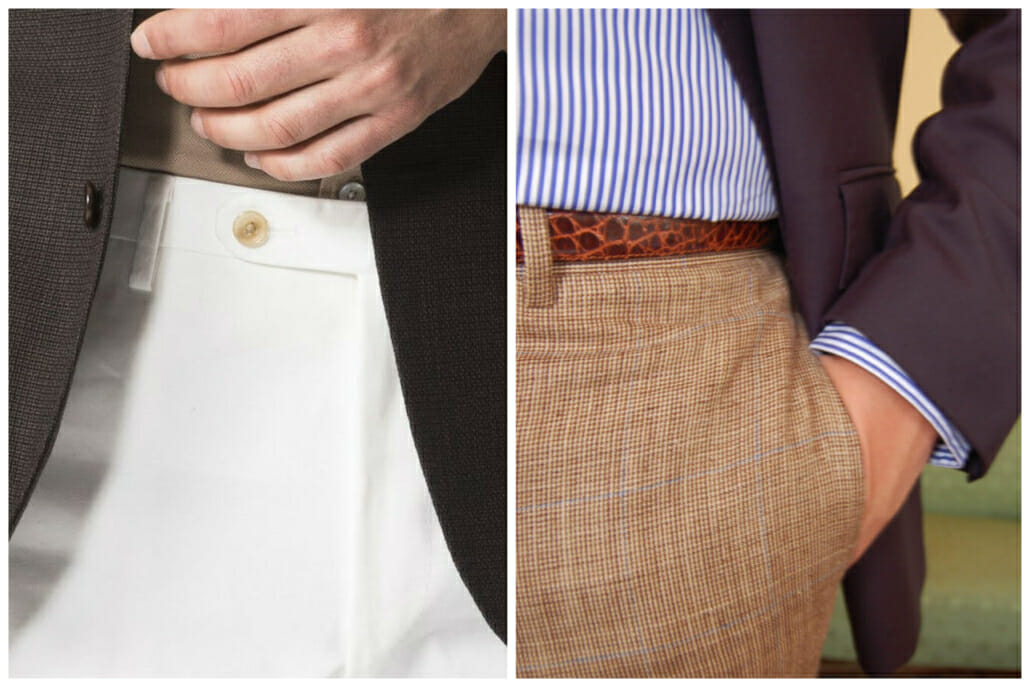Usually, when we think of someone’s style, we envision the entire person, and their “outfit” as a whole. Their style is made up of what they wear from head to toe; it’s a total look or impression. However, it can be useful to consider how we dress from a new angle: we can divide an outfit into sections and use this as a principle of style. Read on for our tips on how to “divide and conquer.”
Beginners: Focus Attention on Part of Your Outfit

The simplest way to apply the principle of dividing in men’s style is by breaking down your outfit into key areas where you can concentrate your attention. With tailoring, the main area of focus on your entire outfit is always the triangle formed above the buttoning point of your suit jacket or sport coat. This includes your tie, visible shirt, and any waistcoat or vest you are wearing. It’s not coincidental that there are so many headless selfies on Instagram with closeups concentrating on this triangle. Sometimes the area is referred to as the “V-Zone,” especially in China, Japan and Korea. This makes sense because the lapels of your jacket form an obvious “V,” but be careful using the term in America as it is also used to refer to a male erogenous zone in magazines like Cosmopolitan.
A lot of your style impact is packed into this inverted triangle, mainly because it exists so near your face, at others’ eye level. This means that if you’re new to dressing well in the classic style, you can direct your efforts here first. The true center of interest here will be your tie, so choose one that lends visual appeal. You can go with the usual printed silk business tie, but to stand out in a way that remains professional, select something unique like a real ancient madder print with its powdery hand feel, or a textured solid grenadine. Another important consideration when focusing on this part of your outfit is your tie width, which should be balanced with that of your jacket’s lapels. A classic lapel width that never goes out of style is 3 to 3.5 inches (about 7.5 to 9 centimeters); your tie should be in the same range to create a pleasing visual balance in this central part of your outfit.

You can also pay more attention to your shirts and choose something other than the usual plain white, perhaps stripes. Lastly, the collar style on your shirt is an often overlooked way to style the “V-Zone.” Instead of getting just anything, pay attention to the collars available, whether a button down, spread, point, round, or something else. You can simply choose a collar you like, or select something that counterbalances your face shape. If you have a wider face, get a collar with points that are closer together, and if your face is narrow, go with a spread collar.

If you wear a pocket square, it technically lives outside the “V-Zone,” but it should be thought of an extension of it. This is especially true if your pocket square is made in the same material as your tie (silk and silk, for example) even if they should NEVER match one another exactly. By virtue of being close together and similar, they’ll be connected visually. Therefore, it’s important for the stylish man to think of both items as being part of the same area. Choose a pocket square that contains a bit of the same color present in your tie, or even your shirt. Alternatively, you could go with a complementary color or pattern–say for example, a polka dot pocket square alongside a tie that has a geometric pattern. The same applies to a boutonniere, which is actually placed on the “V” of your lapel. In the image above, Sven Raphael Schneider has chosen a pink flower to complement the purple of his necktie.

Interestingly, there aren’t really that many other “divisions” in an outfit where style points are as highly concentrated. One other area is your feet, where having nicely polished, quality shoes is important. It’s not recommended that you call too much attention to this area, though. Personally, I avoid too much of a mirror shine or highly ornamented shoes, because it’s preferable to direct people’s attention to your face (via the “V-Zone.” However, when people don’t make eye contact, they do tend to direct their gaze toward the ground, so the appearance of your shoes will still be important. Sophisticated socks that aren’t overly flashy or super bright are another way to enhance this area of your look. If it fits your personality, you can also try some color in your shoelaces. Keep in mind that for this particular region, less is more.
Intermediate: Top and Bottom Halves

1. Sport Coats vs. Suits
When you’re first learning about style, suits are easier than sport-coat and non-matching trouser combinations to coordinate, because you don’t have to worry about matching the jacket with a different colored pair of pants. In fact, the purpose of the suit was originally to create a uniform look from top to bottom through the use of the exact same cloth, an aim that remains today. However, once you are adept at coordinating, you’ll begin to savor the challenge of sport coat and trouser pairings, as the division between top and bottom yields greater complexity and opportunities to be creative. For instance, with a single navy blue jacket you can pair light- or mid-gray pants, brown, beige, rust, burgundy and more. Thus, graduating from suits to the sport coat game is a prime example of how dividing can give you a stylistic advantage.

2. The Importance of the Waistline
But, if we’re talking “division” in the strict sense of the term, there’s no more important line of separation than the one between your top and bottom halves: the waistline. Why is this line between your shirt or jacket and your pants so important? For one thing, the height of this line affects the sense of proportion created. A lot of this depends on the rise of your trousers. If your pants waist sits at your hips, your legs will seem shorter and your torso longer. On the other hand, if you wear pants with a high rise, your upper body will appear shorter and your legs longer.

This is a trick of the eye, an illusion–your body is unchanged–but that’s the power of clothes: they disguise and enhance. It would seem that a mid-height rise on your trousers would be the most appropriate compromise (and it usually is), but if you have very long legs or a short torso, you will want to look for a pair of pants with a lower rise. Conversely, if your legs are short, get a higher rise. The waistline of your pants has a strong visual impact on how your bodily proportions are perceived.
3. Belts as a Tool for Dividing

Another aspect of your waistline that plays a significant role in dividing as a style technique is your average, everyday belt. Many of us wear a belt all the time, without realizing that it actually strengthens the division between top and bottom halves. That’s why a really formal suit or a tuxedo will not have a belt, but rather side adjusters on the pants. For one thing, a leather strap makes your pants more casual, but this is because the belt breaks your outfit in half: you’re adding a strong focal point to your waist, usually in a different color than your shirt, jacket or pants, that disrupts the flow of top and bottom.
This is the opposite principle than that which applies to wearing a wide cummerbund or a waistcoat to cover your waistband when wearing a tux. These are tricks to create more flow between your upper and lower halves, which makes your outfit more formal. You have black pants and a black jacket brought together with a black cummerbund or waistcoat. So, if you want to keep your look really formal, avoid dividing with a belt; use suspenders or side adjusters instead. On the other hand. if you want to dress down your outfit, definitely add a belt.

One instance when a belt is directly used to create a division between your top and bottom halves is when your shirt and pants are the same color, or close to the same. The most common way this happens is in the summer, if you wear white or off-white pants with a white shirt (in the Italian style) and a lightweight sport coat. Without a belt to form a dividing line, the continuous swath of white down the middle of your outfit looks unusual. In this case, a belt with strong features–braided, alligator leather, or colored cloth–is called for. You can also use this technique to create more distinction between shirt and pants that are just slightly off from one another, most likely a white shirt with off-white trousers.

Intermediate: Layering with Vests to Create Separation
A different kind of division is created whenever you layer with an odd (non-matching) vest that is not part of a three-piece suit. This is because a layer in a different color, pattern or fabric creates a visual break with whatever is next to it. As a basic example, if you’re wearing a white shirt and a navy suit jacket, you can pop on a sky blue knit vest to create a division between the two. The break is especially important in two situations. The first is if you have a tie that is the same pattern as your jacket–wearing the two together would look unusual. Throw on a solid waistcoat or knit vest in any color and you create an immediate division between the two to make the combination very wearable. It’s like making a sandwich–the two pieces of “bread” are now separated by the “food” in-between.

The second situation is if you have a tie that is similar in color, but still somewhat different, from the color of your pants or your jacket. Wearing them together can look wrong because the colors are close but slightly “off.” If you put on a knit vest in another color, however, the layer creates a visual separation that disguises the difference, tricking the eye into ignoring the dissimilarity.

Advanced: The Spezzato Technique
The most sophisticated use of dividing as a stylistic technique is spezzato. The technique involves taking the top of one suit (the jacket) and combining it with the bottom of another suit (the trousers). It can also be done with a three-piece suit, by wearing the matching vest and pants from one suit with the jacket of another, or the vest and jacket of one suit with a different pair of pants.

This is like making a sport-coat-and-trouser combination, but mixing and matching from a pair of suits instead. It’s a great way to add versatility to your existing wardrobe. The key to success with this form of division is to choose the same sort of material for top and bottom–both wool, for example–and also in the same weight and cut. You wouldn’t want to mix a summer suit jacket with flannel trousers or a full-cut jacket with slim-fit pants. Another necessity is selecting a suit jacket that resembles a sport coat, like one with natural shoulders and patch pockets. Lastly, be careful not to use the technique of dividing a suit as an excuse to wear a suit jacket with shorts, sweat pants, or even jeans. While this will definitely create a sharp division between top and bottom, it’ll be noticed for all the wrong reasons: because it looks ridiculous. Check out our full article on “How to Divide a Suit” for more detailed advice on the do’s and don’ts.

Conclusion
Dividing is not likely something we think about consciously when approaching classic menswear, but it’s a proven technique that can be accomplished in a variety of ways. Beginners can focus on different quadrants or zones of an outfit to divide and conquer their style. On an intermediate level, you can use a vest or play with your waistline to good effect. Once you’ve mastered this and have a solid collection of suits, you can try the advanced approach of spezzato. Keeping division in mind as a style tool, you open the door to a range of new possibilities.

I don’t usually do it because I think that if yo use much more one of the pieces of a suit will then when again you use it as a suit can be some difference as one of the parts can have more use than the other and then not match as a suit anymore but agree is more versatil then your cloth and probabbly need to buy less tha if not doing that. I will take care of the use i do for each part and start to follow what yo said up here. Whta I will not do is wearing a botton down shirt with a tie or the last two outfits no matter if is Ralph Lauren or whoever and same with the other outfit only if I’m in Bermudas Islands. Thank you for your advice.
Ralph Laurent (real name Ralph Lifschitz) proves that money cannot buy style. How vulgar can you get?
Besides that, another excellent article by Sven that proves we can always learn something new
@Claudio: “Honor those which honor earn’d” — the author of this particular article is Dr. C.Lee, altho Raphael writes very many splendid articles also.
Other than that, I absolutely agree, very useful piece of info which I shall revisit several times in the future.
Additionally, my deepest respect and salutations to the whole staff of GG, keep it up Gents..!!
Ralph Lauren is what is known in the United Kingdom of Great Britain and Northern Ireland, and indeed in the Republic of Ireland, as a silly old git
As a Brit, M’lady, I have to agree that based on the photo above RL does indeed look quite silly.
However, I do think that over the years he has created for his customers some very stylish outfits but in this example, he looks a mess.
It looks like the jeans and trainers [that is what we call sneakers] were photoshopped below the tux.
“This makes sense because the lapels of your jacket form an obvious “V,” but be careful using the term in America as it is also used to refer to a male erogenous zone in magazines like Cosmopolitan.”
I believe “V zone” refers to the female erogenous zone. V = Vag
It is difficult to know which is more stupid looking – Ralph’s formal jacket and jeans or the double breasted structured suit jacket and shorts. I think we have a tie for first place.
Interesting article – thank you!
Great perspective on division! Finally some clarity on when and for what occasions we wear a belt. Thanks for the info!